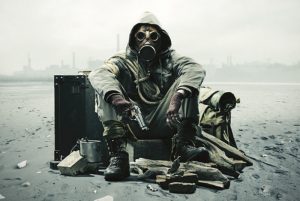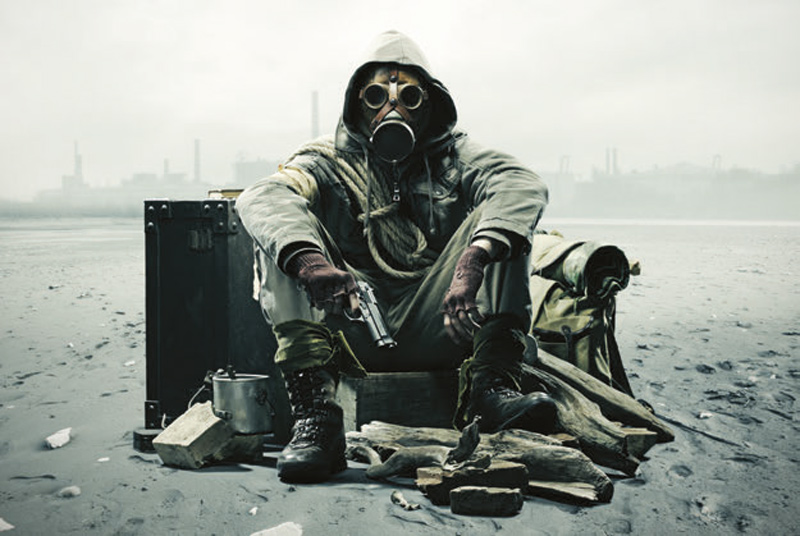HOW prepared are you for a natural disaster? Or an unnatural disaster, for that matter? This being S.W.A.T. Magazine, I’m sure you have sufficient firepower to get you through urban riots, widespread social unrest, or even the zombie apocalypse.
But would you die of thirst before the zombie apocalypse got well underway? Would your family go hungry if storms, strikes, or government edicts cut off food supplies? Would you die from a minor wound because you couldn’t keep it clean? Would you end up in long lines waiting for government help that never came? Would your family end up in some crowded, freezing, wretched tent city surrounded by barbed wire and armed guards (as thousands of victims of Superstorm Sandy did) because you had no plan to evacuate your hard-hit area?
 Two months ago, we looked at what happened to some of Sandy’s victims. Let’s look again. A full three months after the storm (as this is written), hapless homeless people were still filling out FEMA paperwork—and having their applications for aid denied because of paperwork glitches and arcane rules.
Two months ago, we looked at what happened to some of Sandy’s victims. Let’s look again. A full three months after the storm (as this is written), hapless homeless people were still filling out FEMA paperwork—and having their applications for aid denied because of paperwork glitches and arcane rules.
Businesses in Lower Manhattan were still boarded up or running on generators. Churches in Brooklyn were still offering the only hot meals some locals could get. The boardwalks and ferris wheels of coastal tourist towns were being rebuilt. But a few blocks away, uninhabitable houses were falling deeper into ruin while their owners (who still have to make mortgage payments) were shuttled from hotel room to hotel room, never knowing when the government would suddenly stop paying for that “privilege.”
Nobody wants to end up that way. But—people being people—most of us also don’t want to take the practical steps that might keep us out of FEMA tent cities or long lines to get bottled water.
Spring is a good time to re-think preparedness. Catastrophic winter storms are behind us. Catastrophic summer storms haven’t quite arrived. Bad stuff can happen at any time, but right now we’ve probably got a break and we have renewed energy with the return of longer, sunnier days.
This is a fine time to evaluate our preparedness, recheck our supplies, and improve our readiness for whatever life may fling at us—earthquakes, unemployment, flood, fire, or getting stuck in the middle of nowhere on a muddy road.
We might start by evaluating what we’ve already done and still need to do. Here’s a handy-dandy checklist for doing just that. I’m leaving weapons and weaponry skills off since, well, this is S.W.A.T. You’ve got that department covered.
Table of Contents
WATER
The most important element of preparedness is water.
___I have enough clean, drinkable water in every vehicle to get me and my passengers through at least three days should we be stranded and unable to get to safety.
___If I live or travel where it freezes, I have a good method to defrost the water I carry in my vehicle.
___I carry at least one form of water purifier or filter in every vehicle (preferably both a purifier and a filter—you can get simple ones for less than $10 apiece).
___In my home, I have enough stored water to meet my family’s drinking, cooking, and sanitation needs for ___ one week, ___ two weeks, ___ one month or more.
___In my home, I also have water purifiers and/or filters capable of cleaning water in the event of a flood or other disaster that polluted my household water supply. Or I have a means of boiling water that doesn’t rely on grid power.
FOOD
___I carry at least a three-day emergency food supply (nuts, dried fruit, protein bars, not just candy) in every vehicle.
___I have at least one week’s supply of familiar foods that require little or no preparation—foods my family and I can eat right out of the can, box or refrigerator in an emergency.
___I have at least a month’s supply of familiar foods that may or may not require preparation but that my family can eat without the trauma of making a major change in diet (e.g., mac & cheese, canned soups).
___I have ___ three months, ___ six months, ___ one year or more supply of long-term storage foods (rice, beans, honey, freeze-dried or dehydrated items) and someone in my family knows how to prepare them.
FIRST-AID
___Each of my vehicles carries a firstaid kit.
___I have at least one more comprehensive first-aid kit or cabinet at home.
___I have access to a first-aid kit at my workplace, know where it is, and know how to use it.
___I have a Red Cross or other first-aid manual ___ and have studied it.
___I’ve taken (and remember) ___ CPR training, ___ other emergency medical training, ___ CERT (Community Emergency Response Training).
___Every adult in my family knows what’s in our first-aid kits and can use those supplies in an emergency.
___If anybody in my family has special medical needs, we’ve planned for how to deal with those if we have to go ___ (length of time) without power or professional medical help.
BUG-OUTS
___Every member of my family (including pets) has a portable bug-out kit that can get us through at least ___ three days, ___ one week, ___ more without outside help.
___We have chosen one or more safe locations where we can bring our kits in an emergency.
___We have discussed bugging out with relatives or friends. We know what they expect us to bring if we show up at their place in an emergency. They know what we expect them to bring should they need to come to our location.
___I have enough stored and stabilized fuel for my vehicle to get to a preplanned bug-out location.
___I keep the fuel tank(s) in my vehicle(s) at least half full at all times.
___If an emergency prevents me from using my vehicle, my family members and I can carry our bug-out kits and are prepared to walk to a pre-chosen local safe location with our supplies.
OTHER PREPS
___I have smoke detectors (and, if needed, carbon-monoxide detectors) in several places in my house and I change their batteries at least twice a year.
___I have flashlights or lanterns in every vehicle and several rooms of my house. I know where they are and keep their power sources up to date.
___I have a radio with an alternative power source or several alternative power sources (e.g., hand crank, solar, battery, AC).
___I have a generator and fuel for it. ___ It is adequate to power my freezer and refrigerator under their highest startup loads. ___I know how to use it and I test it at least once a year.
___I have alternative emergency sources of light, heat, and cooking that can get my family through ___ one week, ___ two weeks, ___ one month.
___My family and I have a communication plan so that we can either meet up or know where the others will be if an emergency happens when we’re at work, school, or other places we commonly go.
___I have at least $1,000 in readily available cash that I can access when ATMs or bank computers are down.
The above list is hardly comprehensive, but anybody who can check 75% of those items is thinking solidly of his family’s safety when life takes a bad turn. Much more detail on preparedness can be found around the web. If you and your family need more work on preparedness basics, visit my blog (www.backwoodshome.com/blogs/ ClaireWolfe/) and type in the search terms “preparedness priorities” or “bug out.” You’ll find information on water storage and purification, food, first-aid, and creating portable emergency kits.



